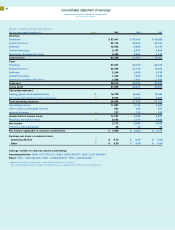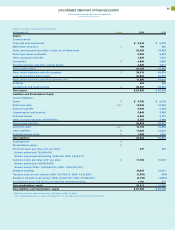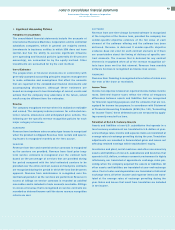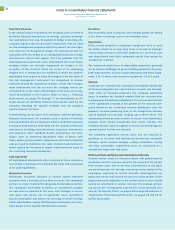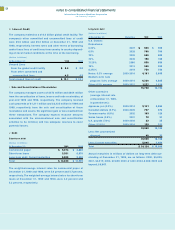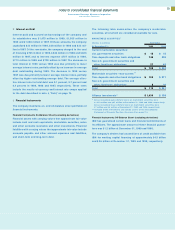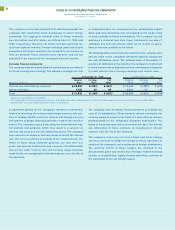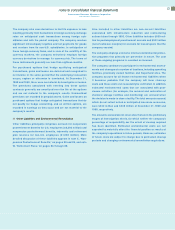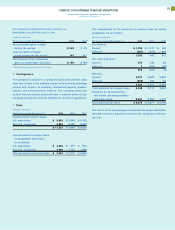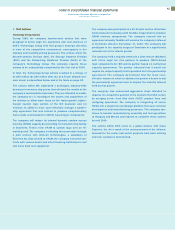IBM 1999 Annual Report Download - page 73
Download and view the complete annual report
Please find page 73 of the 1999 IBM annual report below. You can navigate through the pages in the report by either clicking on the pages listed below, or by using the keyword search tool below to find specific information within the annual report.
notes to consolidated financial statements
International Business Machines Corporation
and Subsidiary Companies
Goodwill
Goodwill is charged to net income on a straight-line basis over the
periods estimated to benefit, generally not to exceed five years.
The company performs reviews to evaluate the recoverability of
goodwill and takes into account events or circumstances that
warrant revised estimates of useful lives or that indicate that an
impairment exists.
Common Stock
Common stock refers to the $.20 par value capital stock as
designated in the company’s Certificate of Incorporation.
Earnings Per Share of Common Stock
Earnings per share of common stock—basic is computed by
dividing Net income applicable to common stockholders by the
weighted-average number of common shares outstanding for
the period. Earnings per share of common stock—assuming
dilution reflects the maximum potential dilution that could occur
if securities or other contracts to issue common stock were
exercised or converted into common stock and would then
share in the net income of the company. See note T, “Earnings
Per Share of Common Stock,” on page 83 for further discussion.
B Accounting Changes
Standards Implemented
The company implemented new accounting standards in 1999,
1998 and 1997. None of these standards had a material effect on
the financial position or results of operations of the company.
Effective January 1, 1999, the company adopted American
Institute of Certified Public Accountants (AICPA) Statement of
Position (SOP) 98-1, “Accounting for the Costs of Computer
Software Developed or Obtained for Internal Use.” The SOP
requires a company to capitalize certain costs that are incurred
to purchase or to create and implement internal use computer
software. See note A, “Significant Accounting Policies” on pages
69 through 71 for a description of the company’s policies for
internal use software.
Effective December 31, 1998, the company adopted SFAS No. 131,
“Disclosures about Segments of an Enterprise and Related
Information,” which establishes standards for reporting operat-
ing segments and disclosures about products and services,
geographic areas and major customers. See note Y, “Segment
Information,” on pages 89 through 93 for the company’s seg-
ment information.
Effective December 31, 1998, the company adopted SFAS No. 132,
“Employers’ Disclosures about Pensions and Other Postretire-
ment Benefits,” which establishes standardized disclosures for
defined benefit pension and postretirement benefit plans. See
note W, “Retirement Plans,” on pages 86 through 88 and note X,
“Nonpension Postretirement Benefits,” on pages 88 and 89 for
the disclosures.
Effective January 1, 1998, the company adopted SFAS No. 130,
“Reporting Comprehensive Income,” which establishes standards
for reporting and displaying in a full set of general-purpose
financial statements the gains and losses not affecting retained
earnings. The disclosures required by SFAS No. 130 are pre-
sented in the Accumulated gains and losses not affecting
retained earnings section in the Consolidated Statement of
Stockholders’ Equity on pages 66 and 67 and in note N, “Stock-
holders’ Equity Activity,” on pages 78 and 79.
Effective January 1, 1998, the company adopted the AICPA
SOP 97-2, “Software Revenue Recognition.” This SOP provides
guidance on revenue recognition for software transactions.
See note A, “Significant Accounting Policies” on pages 69
through 71 for a description of the company’s policy for software
revenue recognition.
Effective December 31, 1997, the company implemented SFAS
No. 128, “Earnings Per Share” (EPS). This statement prescribes
the methods for calculating basic and diluted EPS and
requires dual presentation of these amounts on the face of the
Consolidated Statement of Earnings.
Effective January 1, 1997, the company implemented SFAS No. 125,
“Accounting for Transfers and Servicing of Financial Assets
and Extinguishments of Liabilities.” This statement provides
accounting and reporting standards for transfers and servicing
of financial assets and extinguishments of liabilities.
New Standards to be Implemented
In June 1999, the Financial Accounting Standards Board issued
SFAS No. 137, “Accounting for Derivative Instruments and
Hedging Activities—Deferral of the Effective Date of FAS B
Statement No. 133.” This statement defers the effective date of
SFAS No. 133, “Accounting for Derivative Instruments and
Hedging Activities,” to fiscal years beginning after June 15,
2000, although early adoption is encouraged. SFAS No. 133
establishes accounting and reporting standards for derivative
instruments. It requires a company to recognize all derivatives as
71





